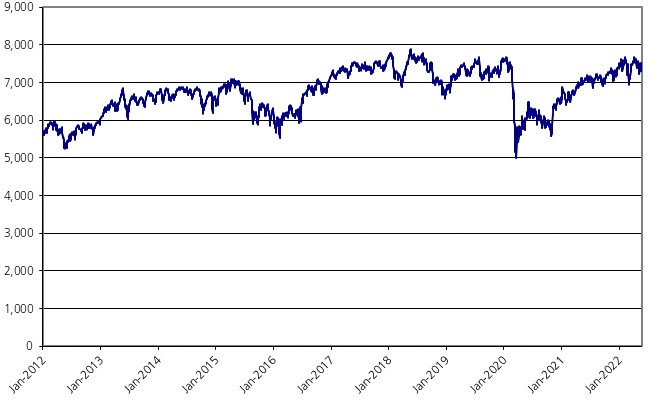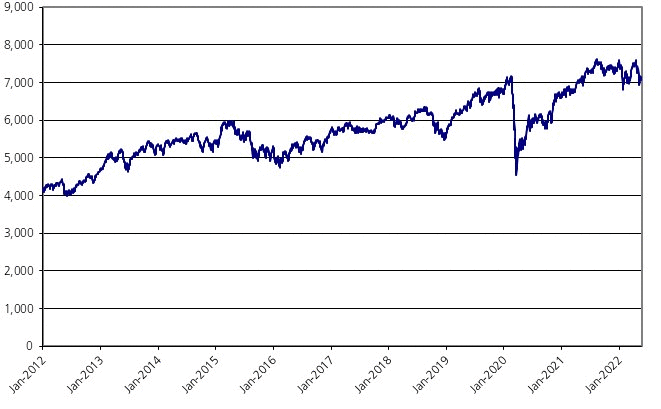|
|
PRICING SUPPLEMENT Dated May 25, 2022 Filed Pursuant to Rule 424(b)(2) (To Prospectus dated March 4, 2022, Index Supplement dated February 24, 2021 and Product Supplement dated February 24, 2021) |
|
UBS AG $34,728,750 Capped GEARS
Linked to an Unequally Weighted Basket of Equity Indices due July 31, 2023
Investment Description
UBS AG Capped GEARS (the “Securities”) are unsubordinated, unsecured debt obligations issued by UBS AG (“UBS” or the “issuer”) linked to an unequally weighted basket (the “underlying basket”) consisting of the following five equity indices (each, a “basket asset”, together the “basket assets”): EURO STOXX 50® Index (40.00% weighting), Nikkei 225® Index (25.00% weighting), FTSE®100 Index (17.50% weighting), Swiss Market Index (SMI)® (10.00% weighting) and S&P/ASX 200 Index (7.50% weighting). The amount you receive at maturity, if anything, will be based on the direction and percentage change in the level of the underlying basket from the trade date to the final valuation date (the “basket return”) and whether the closing level of the underlying basket on the final valuation date (the “final basket level”) is greater than, equal to or less than the initial basket level. If the basket return is positive, at maturity, UBS will pay you a cash payment per Security equal to the principal amount plus a percentage return equal to the lesser of (a) the basket return multiplied by the upside gearing and (b) the maximum gain. If the basket return is 0%, at maturity UBS will pay you a cash payment per Security equal to the principal amount. If, however, the basket return is negative, at maturity, UBS will pay you a cash payment per Security that is less than the principal amount, if anything, resulting in a percentage loss on your initial investment equal to the basket return and, in extreme situations, you could lose all of your initial investment. Investing in the Securities involves significant risks. The Securities do not pay interest and your potential return on the Securities is limited to the maximum gain. You may lose some or all of your initial investment. The contingent repayment of principal applies only if you hold the Securities to maturity. Any payment on the Securities, including any repayment of principal, is subject to the creditworthiness of UBS. If UBS were to default on its obligations you may not receive any amounts owed to you under the Securities and you could lose all of your initial investment.
Features
Enhanced Exposure to Positive Basket Return up to the Maximum Gain: At maturity, the Securities provide exposure to any positive basket return multiplied by the upside gearing, up to the maximum gain.
Contingent Repayment of Principal at Maturity with Potential for Full Downside Market Exposure: If the basket return is 0%, at maturity, UBS will pay you a cash payment per Security equal to the principal amount. If, however, the basket return is negative, UBS will pay you a cash payment per Security that is less than the principal amount, if anything, resulting in a percentage loss on your initial investment equal to the basket return and, in extreme situations, you could lose all of your initial investment. The contingent repayment of principal applies only if you hold the Securities to maturity. Any payment on the Securities, including any repayment of principal, is subject to the creditworthiness of UBS.
Key Dates
|
Trade Date* |
May 25, 2022 |
|
Settlement Date* |
May 31, 2022 |
|
Final Valuation Date** |
July 26, 2023 |
|
Maturity Date** |
July 31, 2023 |
* We expect to deliver the Securities against payment on the third business day following the trade date. Under Rule 15c6-1 of the Securities Exchange Act of 1934, as amended (the “Exchange Act”), trades in the secondary market generally are required to settle in two business days (T+2), unless the parties to a trade expressly agree otherwise. Accordingly, purchasers who wish to trade the Securities in the secondary market on any date prior to two business days before delivery of the Securities will be required, by virtue of the fact that each Security initially will settle in three business days (T+ 3), to specify alternative settlement arrangements to prevent a failed settlement of the secondary market trade.
** Subject to postponement in the event of a market disruption event, as described in the accompanying product supplement.
Notice to investors: the Securities are significantly riskier than conventional debt instruments. The issuer is not necessarily obligated to repay the principal amount of the Securities at maturity, and the Securities has the same downside market risk as that of the underlying basket. This market risk is in addition to the credit risk inherent in purchasing a debt obligation of UBS. You should not purchase the Securities if you do not understand or are not comfortable with the significant risks involved in investing in the Securities.
You should carefully consider the risks described under “Key Risks” beginning on page 3 and under “Risk Factors” beginning on page PS-9 of the accompanying product supplement. Events relating to any of those risks, or other risks and uncertainties, could adversely affect the market value of, and the return on your Securities. You may lose some or all of your initial investment in the Securities. The Securities will not be listed or displayed on any securities exchange or any electronic communications network.
Security Offering
The return on the Securities is subject to, and will not exceed, the “maximum gain” or the corresponding “maximum payment at maturity per Security”. Information about the underlying basket and the basket assets is specified under “Final Terms — Underlying Basket” herein and described in more detail under “Information About the Underlying Basket and the Basket Assets” herein. The Securities are offered at a minimum investment of $1,000, or 100 Securities at $10 per Security, and integral multiples of $10 in excess thereof.
|
Underlying Basket |
Basket Weighting |
Upside Gearing |
Initial Basket |
Maximum Gain |
Maximum Payment at Maturity per Security |
CUSIP |
ISIN |
|
An Unequally Weighted Basket of 5 Equity Indices (see page 2 for further details) |
Unequally Weighted (see page 2 for further details) |
3.00 |
100.00 |
21.75% |
$12.175 |
9026MP809 |
US9026MP8092 |
The estimated initial value of the Securities as of the trade date is $9.746. The estimated initial value of the Securities was determined as of the close of the relevant markets on the date hereof by reference to UBS’ internal pricing models, inclusive of the internal funding rate. For more information about secondary market offers and the estimated initial value of the Securities, see “Key Risks — Estimated Value Considerations” and “Key Risks — Risks Relating to Liquidity and Secondary Market Price Considerations” beginning on page 5 herein.
See “Additional Information about UBS and the Securities” on page ii. The Securities will have the terms specified in the accompanying product supplement relating to the Securities, dated February 24, 2021, the accompanying prospectus dated March 4, 2022 and this document.
Neither the Securities and Exchange Commission nor any other regulatory body has approved or disapproved of these securities or passed upon the adequacy or accuracy of this document, the accompanying product supplement, the index supplement or the accompanying prospectus. Any representation to the contrary is a criminal offense.
The Securities are not bank deposits and are not insured by the Federal Deposit Insurance Corporation or any other governmental agency.
|
Offering of Securities |
Issue Price to Public |
Underwriting Discount |
Proceeds to UBS AG |
||||||
|
|
Total |
Per Security |
Total |
Per Security |
Total |
Per Security |
|||
|
Securities linked to an Unequally Weighted Basket of Equity Indices |
$34,728,750.00 |
$10.00 |
$694,575.00 |
$0.20 |
$34,034,175.00 |
$9.80 |
|||
UBS Financial Services Inc. UBS Investment Bank
i







